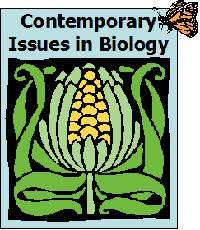
Week 13, Chapter 10 -- Freelance Writer Sample Answer
Course home | Weekly schedule | Announcements | Instructor Info | Desire2Learn | MasteringBiology® | Honor Code | FAQs | HELP!
 |
Week 13, Chapter 10 -- Freelance Writer Sample AnswerCourse home | Weekly schedule | Announcements | Instructor Info | Desire2Learn | MasteringBiology® | Honor Code | FAQs | HELP! |
“New mouse species found in the Philippines” – June 1, 2004
http://www.sciencedaily.com/releases/2004/05/040531213018.htm [note that this story is much older than what yours is allowed to be]
[The theme of this installment is NBC's Today Show -- specifically, it is an interview with the scientist who discovered the new species.]
Katie Couric: Good morning! Today we will be discussing evolution and the new species of mouse that was found in the Philippines recently. The co-leader of the team and curator of mammals at The Field Museum in Chicago, Dr. Lawrence Heaney, is here with us this morning. Welcome, Dr. Heaney!
Lawrence Heaney: Good morning, Katie!
Katie Couric: While on your trip to the Philippines, I understand that you came across a unique animal.
Lawrence Heaney: Yes, Katie. We discovered a new species of mouse, possibly even a new genus. One thing is for sure, this specimen is like no other species of rodent.
Katie Couric: Words such as “genus” and “species” are quite confusing; would you mind explaining what you mean?
Lawrence Heaney: Of course not, Katie. Every animal is classified in the same classification system, which organizes life by kingdom, then phylum, then class, order, family, genus, and species. The broadest category is kingdom – all animals, from beetles to horses, fit in the same kingdom. Plants have a different kingdom, as do fungi. The narrowest category is species, which means a single type of organism. Genus is one group right above species.
Katie Couric: Oh, I see. So the new specimen could be in its own new genus rather than just a new species. Do new discoveries such as this occur very often?
Lawrence Heaney: Well, probably more than you think, but you must remember that it takes generations for speciation to occur and produce two completely separate populations.
Katie Couric: So what is this new specimen like? What sets it apart from other mice?
Lawrence Heaney: For starters, this specimen is bright orange, and it has two sets of whiskers – one set near its mouth, and another near each eye. The mouse is seven inches long, including the tail, and it weighs fifteen grams.
Katie Couric: What does it eat?
Lawrence Heaney: It has really muscular jaws, and it looks like it has a powerful bite. It probably eats nuts and other hard foods.
Katie Couric: Is this mouse a pest to the people of the Philippines, like mice are here?
Lawrence Heaney: Oh, I doubt it. This mouse lives in trees, not inside of homes.
Katie Couric: Wow, this is amazing! Did you only find one specimen?
Lawrence Heaney: Yes, we believe the numbers for the species are way down because people have been logging their natural forested habitat. However, the farmers in this region now realize that an intact forest is the best way to protect their water supply. So they are strongly dedicated to replanting the native forest, which can only help this new species of mouse.
Katie Couric: This is all fascinating and we look forward to having you come back for future discoveries.
Lawrence Heaney: Thank you, Katie!
[488 words]
References:
Belk, C. and V. Borden. 2007. Biology: Science for Life, Second Edition. Pearson Prentice Hall. Upper Saddle River, NJ.
Author unknown. June 1, 2004. New mouse species found in the Philippines. http://www.sciencedaily.com/releases/2004/05/040531213018.htm. Downloaded November 10, 2009.
[Back to Freelance Writer Assignment]
[Sample assignment by Andie Nix]